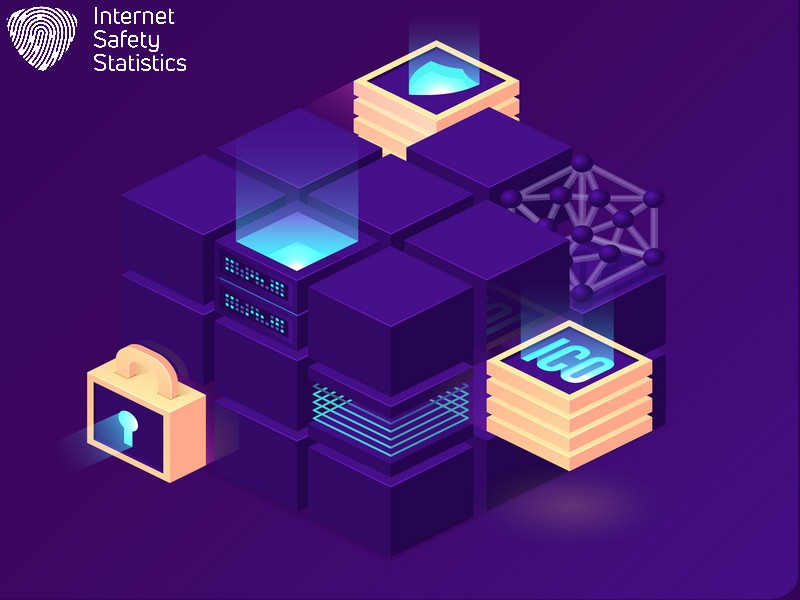
The digital landscape thrives on information exchange, but this convenience often comes at the cost of compromised privacy. Our data constantly circulates across various platforms, raising concerns about unauthorised access and potential misuse. Blockchain technology is a potential game-changer for online privacy in this ever-evolving environment.
What are the basics of Blockchain technology? It acts as a secure and decentralised digital ledger, fundamentally altering how data is stored and managed. Unlike traditional methods where a central authority controls data, blockchain distributes information across a vast network of computers. This decentralisation makes data tampering highly difficult and fosters greater transparency. Additionally, blockchain utilises robust encryption techniques, rendering data unreadable to anyone without the decryption key.
This introduction explores the core principles of blockchain technology and its potential implications for online privacy. We’ll delve into how blockchain’s decentralised nature and encryption capabilities can empower individuals to regain control over their personal information. By understanding the fundamentals of blockchain, you can gain valuable insight into the future of data privacy and how this technology might revolutionise how we interact online.
This blog post is your guide to understanding how blockchain can secure private details without overwhelming you with complex jargon. Stay safe online; let’s explore blockchain’s protective power together!
Overview of Blockchain Technology
Blockchain technology is a form of distributed ledger that records and verifies transactions across a network of computers. It is known for its immutability, meaning once data is recorded, it cannot be altered or deleted, and transparency, as all participants can view the entire history of transactions on the blockchain.
Immutability
Immutability in blockchain means once data gets recorded, it cannot be altered or deleted. This feature is like a digital stone carving; information stays permanent and unchangeable. It ensures transaction data remains secure forever, providing a trustworthy foundation for records and dealings.
The rock-solid stability of immutable ledgers assures users of the confidentiality and integrity of their information. Every piece of data stamped on a blockchain gains protection through advanced cryptographic algorithms that lock in its state.
For parents worrying about their family’s digital safety or office workers concerned with secure communication, this aspect of blockchain technology offers peace of mind that once information goes into the ledger; it’s safeguarded against tampering and forgery.
Transparency
Transparency in blockchain technology means that the data recorded on the network is visible and accessible to all participants. This fosters trust and accountability among users, as they can verify transactions and track the flow of information without relying on a central authority. By providing an open and traceable record of activities, blockchain ensures every transaction is visible while maintaining user privacy through encryption techniques.
The transparency of blockchain also allows for improved security measures, enabling users to authenticate transaction data and ensure the system’s integrity. At its core, blockchain’s transparency empowers individuals by giving them visibility into their digital identity and personal data stored within the network.
Privacy Concerns in Traditional Systems

Centralised systems pose a risk to privacy as they are vulnerable to data breaches and violations. This has led to the need for improved privacy solutions in traditional systems.
Centralised Systems
Traditional systems often rely on centralised databases, where a single entity or authority controls the storage and management of data. In such systems, sensitive information is susceptible to breaches and violations due to the concentrated nature of control.
Centralised systems are vulnerable to cyber-attacks, increasing data protection and privacy concerns. As a result, blockchain technology offers an alternative approach by decentralising data storage and enabling secure communication through encryption and pseudonymity. Centralised systems present risks for privacy protection as they lack the inherent security qualities of decentralisation and cryptographic techniques found in blockchain networks.
Data Breaches and Violations
Centralised systems require a single control point, leaving them vulnerable to data breaches and violations. Personal information stored in a centralised database can be compromised by cybercriminals, leading to privacy violations and potential misuse of sensitive data. Encryption is utilised to secure the information, but once the central authority is breached, all the data becomes exposed.
Blockchain technology resolves these issues by distributing transaction data across a network. This decentralisation safeguards against large-scale data breaches and ensures that personal information remains safe and secure from unauthorised access or manipulation.
The Need for Improved Privacy Solutions
Improved privacy solutions are essential to address the increasing concerns surrounding data breaches and violations in traditional systems. The demand for enhanced privacy stems from existing platforms’ centralised nature, making them vulnerable to cyber threats.
Implementing robust privacy measures is critical to safeguard personal information and transactional data from unauthorised access and misuse. Blockchain technology offers a promising solution by leveraging encryption, pseudonymity, and smart contracts to enhance privacy features effectively.
The need for improved privacy solutions arises from the escalating challenges in maintaining data security within centralised systems. As technology advances, adapting to enhanced privacy-preserving mechanisms that can balance transparency and confidentiality efficiently becomes imperative. With growing cybersecurity threats and an increased focus on information security, there is a compelling need for improved privacy solutions that align with evolving regulatory requirements.
Privacy Features of Blockchain Technology
Blockchain technology incorporates various privacy features such as encryption and cryptographic techniques, pseudonymity, anonymity, smart contracts, and privacy settings to protect user data. These features provide a secure and private environment for transactions and interactions within the blockchain network.
Encryption and Cryptographic Techniques
Blockchain technology employs encryption and cryptographic techniques to protect the privacy of its participants. Using sophisticated cryptographic algorithms and hashing methods, blockchain ensures that personal data is secure and immutable. This enables the tracking and storage of personal information in a safeguarded manner, assuring users that their data remains safe within the blockchain network.
Moving forward, let’s delve into the concept of pseudonymity and anonymity in blockchain technology.
Pseudonymity and Anonymity
Blockchain technology ensures pseudonymity and anonymity by allowing users to conduct transactions without revealing their real identities. Pseudonymity refers to using a fictitious name or identifier in place of one’s real identity, providing a layer of privacy for users while maintaining transparency within the network.
This feature allows individuals to engage in secure transactions without disclosing personal information. On the other hand, anonymity involves concealing any identifiable information when participating in blockchain activities, offering additional privacy protection for users.
Implementing cryptography and privacy-preserving technologies further enhances the confidentiality and security of user data on the blockchain network. This enables selective disclosure of transaction details while safeguarding sensitive personal information from unauthorised access or exploitation.
Smart Contracts and Privacy Settings
Smart contracts are self-executing contracts with the terms of the agreement directly written into code. They automatically enforce and facilitate the negotiation and performance of a contract without third-party intermediaries.
Privacy settings in smart contracts can be customised to allow for selective disclosure of information, ensuring that sensitive data remains confidential. These privacy-preserving features enable secure authentication of transaction data while preserving user anonymity. Smart contracts use cryptographic techniques to provide privacy-protecting mechanisms, safeguarding personal information from unauthorised access within blockchain networks.
Privacy technology inherent in smart contracts establishes secure authentication for cryptocurrency transactions. This functionality ensures that only authorised parties can access specific transaction details, enhancing confidentiality for individuals engaging with blockchain platforms.
Transparency vs Privacy
Risks and challenges in implementing privacy in blockchain highlight the balance between transparency and privacy. While blockchain offers transparency through its decentralised nature, it prioritises privacy by protecting user identities through encryption and pseudonymity.
Blockchain technology ensures that personal data is stored securely through cryptographic techniques, maintaining a delicate equilibrium between visibility and confidentiality. The immutability of blockchain safeguards personal information while allowing for transparent transactions, thus providing a robust privacy-preserving solution grounded in secure technology. Decentralised identity systems establish trust without compromising security or reliance on intermediaries, ensuring authentication transaction data remains private yet verifiable.
Balancing Transparency and Privacy in Blockchain
Public blockchains provide a high level of transparency but may compromise privacy. Private and permissioned blockchains offer more control over who can access information but may lack the transparency fundamental to blockchain technology.
Privacy-enhancing technologies and decentralised identity systems aim to balance these aspects in the blockchain.
Public Blockchains
Public blockchains are open and accessible to anyone, allowing all participants to view and verify transactions. These blockchains provide a high level of transparency, enabling users to track the flow of digital assets without intermediaries such as banks or financial institutions.
Personal data stored on public blockchains is secured through encryption techniques, ensuring privacy protection while maintaining the integrity of the network.
Blockchain technology ensures that sensitive information remains confidential by leveraging cryptographic algorithms and decentralised consensus mechanisms. With public blockchains, individuals can have confidence in their data security while benefiting from the advantages of a transparent and immutable ledger system.
Private and Permissioned Blockchains
Private and permissioned blockchains operate within a closed network, giving access only to approved participants. This restricted access ensures greater privacy and control over data sharing than public blockchains. With private blockchains, users can perform transactions securely without exposing sensitive information to the public. Additionally, permissioned blockchains enable designated entities to validate transactions and maintain the network’s integrity without compromising privacy.
These features make private and permissioned blockchains suitable for businesses seeking enhanced data protection while maintaining operational transparency. As such, organisations can streamline their workflows, ensuring that confidential information remains secure within a controlled environment. Implementing these blockchain types empowers proper management of sensitive data while upholding privacy standards in various industries.
Privacy-Enhancing Technologies
Blockchain technology utilises several of the following technologies to enhance your data’s privacy. From encrypting data to using cryptographic techniques to complying with data protection regulations, blockchain technology is working towards better data privacy.
- Encryption and Cryptographic Techniques: Blockchain employs advanced encryption methods to safeguard sensitive data, ensuring that only authorised parties can access it.
- Pseudonymity and Anonymity: Using pseudonyms or anonymous identifiers, blockchain allows for secure and private transactions without revealing personal information.
- Smart Contracts and Privacy Settings: Smart contracts enable parties to set specific privacy parameters, ensuring that only relevant information is accessible to involved parties.
- Transparency vs Privacy: Blockchain provides a balance between transparency and privacy, allowing users to control the visibility of their data while maintaining an immutable record of transactions.
- Decentralised Identity Systems: Blockchain facilitates the development of decentralised identity systems, enabling individuals to have greater control over their personal information.
- Compliance with Data Protection Regulations: Blockchain technology aids in complying with data protection regulations by providing secure data storage and enabling transparent yet privacy-preserving transactions.
- Risks and Challenges in Implementing Privacy in Blockchain: It’s crucial to acknowledge and address the inherent risks associated with implementing privacy features in blockchain, ensuring that they are robust enough to withstand potential threats.
Decentralised Identity Systems

Transitioning from privacy-enhancing technologies, decentralised identity systems in blockchain technology offer a promising solution to safeguard personal information. By allowing individuals to take control of their digital identities, these systems eliminate the need for central authorities to manage personal data.
Users can securely manage their identities through cryptographic techniques and decentralisation while ensuring privacy protection. This enhances security by reducing the risk of data breaches and unauthorised access.
Blockchain’s decentralised identity systems provide a secure and transparent platform for managing digital identities without compromising privacy. Individuals can have greater control over their personal information, enabling them to share specific details with trusted parties while maintaining anonymity when necessary.
Compliance with Data Protection Regulations
Blockchain technology must align with data protection regulations to transition from decentralised identity systems. Compliance with these regulations ensures that personal information stored on the blockchain remains secure and private. Blockchain’s encryption and cryptographic techniques enable adherence to data protection laws by providing a secure environment for personal data storage, safeguarding it against unauthorised access or breaches.
By leveraging pseudonymity and anonymity features in transactions, blockchain technology offers a privacy-preserving solution that meets the requirements of data protection regulations while ensuring transparency where needed. Blockchain technology aligns with privacy protection principles stipulated in data protection regulations through its immutable nature, which helps entities track and store personal data securely.
Risks and Challenges in Implementing Privacy in Blockchain
Implementing privacy in blockchain technology poses various risks and challenges. Encryption techniques used in blockchain can be vulnerable to quantum computing, potentially compromising the security of the stored data.
Additionally, maintaining a balance between transparency and privacy is essential but daunting due to differing regulatory requirements across various jurisdictions. The complexity of implementing privacy solutions in blockchain also leads to potential issues with interoperability between different platforms. Furthermore, ensuring compliance with data protection regulations such as GDPR requires continuous updates and maintenance, adding a layer of challenge to the implementation process.
Blockchain technology offers a secure and transparent way to protect privacy. It utilises encryption and cryptographic techniques to safeguard personal data. The balance between transparency and privacy is achieved through pseudonymity and anonymity. Blockchain’s decentralised nature ensures compliance with data protection regulations while addressing the risks and challenges of implementing privacy.
FAQs
1. What is blockchain technology, and how does it protect privacy?
Blockchain is a secure, digital ledger system that maintains privacy by keeping data decentralised and making record alterations detectable.
2. Can blockchain be used as privacy-preserving technology?
Yes, blockchain can be a powerful privacy-preserving tool because it allows for secure transactions without exposing sensitive personal information.
3. How does understanding the basics of blockchain benefit my knowledge of privacy protection?
Grasping the fundamentals of blockchain equips you with insight into how this technology offers robust methods to safeguard your data against unauthorised access.
4. Is using blockchain complicated if I’m concerned about online privacy?
While the underlying mechanics of blockchain might seem complex, utilising this technology for privacy protection purposes has been streamlined through user-friendly applications.
